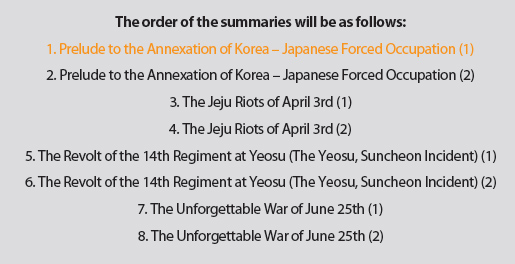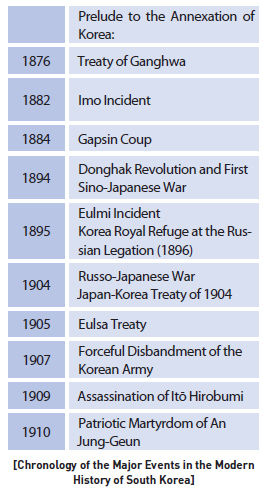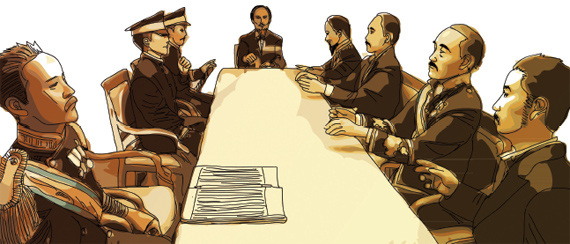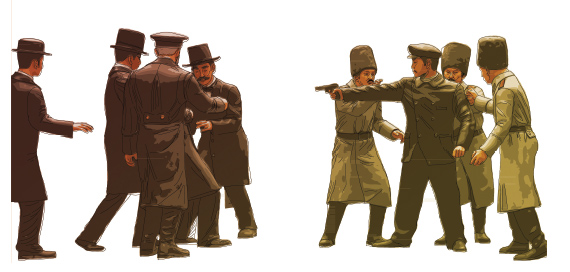|
Special Project - Having an Accurate Understanding of Korea’s Modern History
|
|
|
글쓴이 :
관리자
|
|
The history of Korea plays a part in our own history as individuals. The person who does not know his or her nation’s history cannot establish a proper identity. Moreover, Korea’s modern history is a setting that shows God’s sovereignty and His providential intervention, that He does not rest for one minute or even a second in order to bring redemption to mankind. At a time when humanistic discourses that distort and trivialize this history are rife in our midst, Senior Pastor Abraham Park has published an account of Korea’s modern history entitled A Series on the Modern History of Korea, a fourbooklet series, through Huisun. Through this series, future generations will be able to obtain a correct and righteous view of their own history founded on God-centeredness. Champyungan will summarize the contents of the booklet series over eight monthly issues.

Communism entered this nation during the Japanese forced occupation, and first began to rise in opposition to the corruption found within the royal court during 1876~1910. It was this corruption that brought about the Japanese occupation of Korea.

1. Prelude to the Annexation - Deterioration and Corruption in the Royal Court
During the decline of the Chosun era (the period before the annexation), fights among different factions gave way to deep-seated corruption within the royal court. These officials focused only on aristocratic ideals and did nothing to increase their nation’s wealth or the strength of her army. Furthermore, the nation’s treasury was exhausted as a result of political corruption and unscrupulous officials (even from the provincial areas), resulting in an imposition of harsh taxes on the common people and bringing a never-ending burden to the people’s shoulders.
2. The Beginning of Japan’s Infiltration into Korea
1) Treaty of Ganghwa - (Japan-Korea Treaty of Amity) Year 1876
In April 1875, the Japanese government dispatched the warship Unyo to Ganghwa Island. Landing ashore, the Unyo’s barbaric acts of plundering and bloodshed and its clash with our own defense forts became known as the “battle of Ganghwa.” Using the excuse that they would investigate those responsible for Unyo’s artillery attack, the Japanese government landed eight warships and a military force consisting of approximately 600 men on Ganghwa to enforce negotiations. This resulted in the Japan-Korea Treaty of Amity. While this treaty made it seem as though Chosun’s ports would be open for trade, in truth it was the same as Korea opening her boundaries for colonization.

2) Imo Incident - Year 1882
The Imo incident of June 5, 1882, arose from the discriminatory treatment of the old army in favor of the modern army, unpaid wages, and dissatisfaction with ration allowances.
The soldiers’ discontentment escalated, ending in a riot and the murder of a high-ranking government official. Past and present civilizations have taught us that a nation that disregards and neglects its own army never prospers.
The main cause for our nation’s terrible violation during the period before her annexation was because of the officials whose only purpose was in the perpetuation of their archaic aristocratic ideals. In 1897, Emperor Gojong of the Korean Empire made public the incident of Unyo, but by then it was too late. When Japan invaded the Korean Empire in 1910, her mobilized military force consisted of merely the Second Infantry Division.
3. Japan’s Undisguised Entrance into Korea
1) Eulmi Incident - Year 1895
After the Sino-Japanese War, Japan’s unofficial yet growing, inequitable hold on Korea was temporarily put to a halt by Empress Myeongseong’s vigorous anti-Japanese movement. The Eulmi incident was an incident that took place on October 8, 1895, when the Japanese gathered a mob composed of the army, police officers, and the unemployed and forcibly entered Gyeongbokgung Palace in the early hours of the morning to assassinate Korea’s mother of the state, Empress Myeongseong. The Japanese mobsters grabbed Empress Myeongseong’s head, tossed her into the courtyard, then wielding a Japanese sword, hacked at her repeatedly and poured kerosene over her to burn her corpse. The Empress of Korea, who stood as Japan’s greatest stumbling block in the invasion of Chosun, was murdered at the relatively young age of 45 like a wild beast at the hands of the Japanese troops.
2) Korea Royal Refuge at the Russian Legation - Year 1896
The Eulmi incident brought great fear to the royal household in the palace. On the morning of February 11, 1896, King Gojong and the crown prince rode on palanquins and, under disguise, escaped through the royal palace gate with great difficulty and took refuge at the Russian legation. Thus, for about a year, the royal household remained absent from the palace and dwelled in the Russian legation, an event known as the “Korea Royal Refuge at the Russian Legation.” On February 20, 1897, Gojong returned to Gyeongungung from the Russian legation, and in October of the same year, made a constitutional proclamation of the founding of the Empire of Korea. He was crowned Emperor at the coronation held at the palace.
3) Russo-Japanese War and Japan-Korea Treaty - Year 1904
On February 8, 1904, a Japanese fleet launched a surprise attack on a Russian fleet at Port Arthur (Lushun). The next day, there was a violent collision of the two fleets near the waters of Incheon. Each nation had propagandized to its people for ten days prior to the initiation of the war. The Japanese requested the negotiation of an agreement with Korea, one that would be advantageous to their side of the war. This became known as the “Japan-Korea Treaty of 1904.” On the surface, the agreement was negotiated under the pretext that it was for the safety and welfare of the empire of Korea; in truth, however, it was a tactical move that was made in preparation for the Russo-Japanese War, arranged so that the Japanese could annex the empire of Korea on a long-term basis without any obstruction. The Japanese had won the First Sino-Japanese War (1894~1895), and had now won the Russo-Japanese War in 1905. They soon organized and induced a group of staunch pro-Japanese Cabinet members to be at the side of Emperor Gojong, and stationed 20,000 soldiers at Yong-san.

4) Japan-Korea Protectorate Treaty (Eulsa Treaty) - November 17, 1905
On the afternoon of November 17, 1905, Ito Hirobumi surrounded the front of Deoksugung Palace and its conference center with a fully dressed and equipped Japanese army. Eight hundred cavalrymen, 5,000 artillerymen, and 20,000 foot soldiers secured the entire district of the city of Seoul. Emperor Gojong refused the five clauses Ito Hirobumi demanded of him to the end. In response, Ito Hirobumi opened a conference with the government in the king’s royal presence and threatened the participating Cabinet members into consenting to the contractual clauses of the agreement. All the Cabinet members, apart from Han Gyu-seol, Lee Young-ha, and Min Young-ki, signed their consent. Ito Hirobumi placed Lee Wan-yong, Lee Geun-taek, Lee Ji-yong, Park Jae-soon, and Kwon Joong-hyun at the forefront to proclaim their approval of the agreement. These men who sold their nation and helped bring the Japan-Korea Protectorate Treaty to fruition are known as the “Eulsa Five.” At the end, Japan took away Korea’s diplomatic powers and sent a Resident-General to manage her affairs.
5) Forceful Abdication of Gojong - July 19, 1907
In order to contest the forced removal of the empire of Korea’s independence, Emperor Gojong secretly dispatched Lee Jun, Lee Sang-seol, and Lee Wi-jong to the Second Hague Peace Conference being held at the Hague, Netherlands.
However, Japan’s interference prevented them from accomplishing their mission. Using the Hague emissary as a reason, Ito Hirobumi forced Gojong to abdicate on July 19, 1907.
6) Forceful Disbandment of the Korean Army - August 1, 1907
On August 1, 1907, at 9 a.m., Japan issued a command for the disbandment of the Korean army. The Korean army, the last bastion of the empire of Korea, was forcibly disbanded and rendered completely powerless.
4. The Heroic Deed of Patriot An Jung-geun - October 26, 1909, 10 a.m.
1) An Jung-geun’s Birth and His Participation in the Armed Resistance
An Jung-geun was born on September 2, 1879, in Haeju, Hwanghae-do, below Suyang Mountain in Gwangseokdong. He was the eldest son of An Tae-hoon and Jo Maria. An Jung-geun the patriot felt strongly about the necessity of armed resistance. He founded the very first overseas resistance group (Korean Army of Justice) and began to prepare for war. In March 1909, An Jung-geun gathered with 12 fellow independence fighters, where each fighter cut off one of his fingers at the distal interphalangeal joint. With their blood, they wrote “Liberate Korea” on the Korean flag, simultaneously shouted “Long live Korean independence!” three times, and then made a pledge before heaven and earth.
2) Assassination of Ito Hirobumi - October 26, 1909
In October 1909, An Jung-geun discovered through reading the newspaper that Ito Hirobumi would be at Harbin for a meeting with a representative of the Russian Empire.
The historic event of October 26, 1909, was guided from above. On this specific day, security was lax as the Japanese and Russians entered the train station. At last, Ito Hirobumi’s train arrived at 9:15 a.m., and a diminutive old man stepped out. An Jung-geun immediately walked toward Ito Hirobumi (about a distance of five meters), pulled out his pistol and, without hesitation, shot Ito Hirobumi on the right side of his chest. Ito Hirobumi was shot three times. For a brief instant, chaos and confusion filled Harbin Station. Ito Hirobumi was taken into a train suite, but died 15 minutes later at 10:15 a.m. from excessive blood loss. Patriot An Jung-geun, who executed his mission successfully, boldly pulled out the Korean flag and, gazing up at the sky, shouted “Ura Korea!” three times (“Long live the Empire of Korea!”). He was immediately arrested on the spot. Ito Hirobumi’s punishment as meted out by patriot An showed the spirit of a nation to the world, planted hope and courage into the nation’s populace, and woke the slumbering national awareness of the citizens.
3) Patriotic Martyrdom after 144 Days in Lushun Pris-on-March 26, 1910
According to trial records, when the public prosecutor asked why he had shot Ito Hirobumi to death, An Junggeun the patriot answered by listing 15 crimes committed by Ito Hirobumi. The incident of patriot An’s shooting of Ito became known to the world. At home and abroad, prominent lawyers stepped forward to offer to take on his case, and active campaigns were held to raise funds for An’s trial. However, Japan substituted a Japanese government-appointed lawyer and held six quick trials at the district criminal court for An Jung-geun.
On February 14, Judge Manabe sentenced patriot An Jung-geun to death. Upon hearing this verdict, An Junggeun’s mother, Jo Maria, sent a letter that read, “You were born a hero, and have done a great deed for your country. You are the glory of our family. At church, the saints gather and pray on your behalf. And now, let us meet in the peaceful heavenly kingdom.” Along with the letter, she sent a shroud that she had made for her son.
On the day before his execution, patriot An Jung-geun’s brother came to see him. The first thing An Jung-geun wanted to know was the health of their old mother. He then asked to be given the Last Sacraments. In addition, after offering a prayer with his two younger brothers, An Jung-geun left a testament that read, “Even when I am in heaven, I shall continue to work for the recovery of our nation. When the joyous shout of Korea’s independence reaches heaven, I will fittingly dance and cry out ‘Hurrah!’"
On March 26, 1910, five months after his brave mission, An Jung-geun’s life came to an end via hanging at a prison in Dalian city near Lushun. He was only 31 years of age.
Japan hid away An’s remains in a similar-looking tomb in a graveyard afraid that the burial site for patriot An might become the birthing ground for Korea’s independence movement in the event that Japan sent his remains back to his country. To this day, his resting place has not yet been found.
Summary by reporter Ji Geun-ook, Illustrated by Jung Euy-jun
|
|

